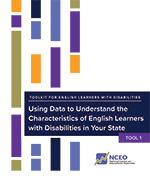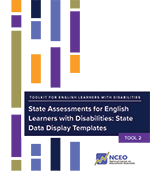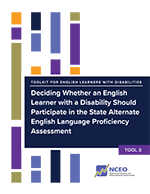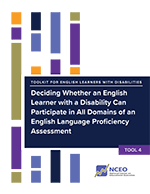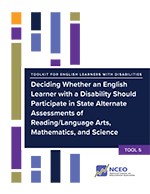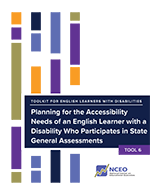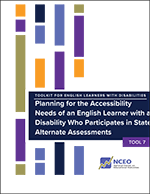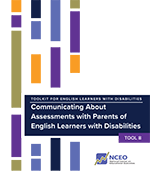NCEO recently published a new series, The English Learners with Disabilities Toolkit, that provides resources for states and IEP teams to determine appropriate assessment participation for English learners with disabilities, particularly English learners with the most significant cognitive disabilities. The toolkit addresses critical assessment challenges under the Every Student Succeeds Act (ESSA) and Individuals with Disabilities Education Act (IDEA). The toolkit provides states and Individualized Education Program (IEP) teams with essential tools to determine appropriate assessment participation for English learners with disabilities, particularly English learners with the most significant cognitive disabilities. It offers guidance on examining data to determine the characteristics of a state’s population of English learners with disabilities, selecting between general and alternate assessments, helping teams make informed decisions about assessment participation, and determining appropriate individualized accessibility features on assessments. States can customize the toolkit’s resources to reflect their specific population of English learners with disabilities.
The English Learners with Disabilities Toolkit includes eight customizable tools:
This tool is designed to provide state education agencies (SEAs), particularly assessment staff, with templates to use to display data on the characteristics of English learners with disabilities. The tool includes templates for examining languages spoken at home, disability categories, and English language proficiency (ELP) levels on both the general and alternate ELP assessments. States may customize this tool as needed to meet their needs.
This State Data Display Templates tool is designed to provide state education agencies with templates to use to display state assessment participation and student characteristics data for English learners with disabilities. The templates are designed for a closer look at State assessment data but may be adapted for use with other types of assessments.
This tool provides states with components to help ensure that all potential decision makers are informed about the state’s English language proficiency (ELP) assessments. It also provides considerations for making the decision about whether a student who is an English learner with a disability should participate in the alternate ELP assessment or the general ELP assessment. States may customize this tool as needed to meet their needs.
This tool describes a way to ensure that all potential assessment participation decision makers are informed about the state’s English language proficiency assessments. It includes considerations for making a decision about exempting an individual English learner with a disability from participation in a particular English proficiency domain because the disability prevents access to that domain. States may customize this tool as needed to meet their needs.
This tool describes a way to ensure that all potential assessment participation decision makers are informed about the state’s content assessments and considerations for determining whether a student who is an English learner with a disability should participate in the alternate assessment based on alternate academic achievement standards (AA-AAAS) or the general content assessment. A list of resources on decision-making approaches for content assessments is included. States may customize this tool as needed to meet their needs.
This tool describes a planning process for determining the access needs of an individual student who is an English learner with a disability and will take state general assessments. It includes components of a sample accessibility plan for an English learner with a disability and a model of a completed plan. The sample accessibility plan is designed to supplement the IEP. States may customize this tool as needed to meet their needs
This tool describes a planning process for determining the access needs of an individual student who is an English learner with a disability and will take state alternate assessments. It includes components of a sample accessibility plan for an English learner with a disability who participates in alternate assessments and a model of a completed plan. The sample accessibility plan is designed to supplement the IEP. States may customize this tool as needed to meet their needs.
This tool contains information that states can use to ensure their parent-focused assessment information is inclusive of assessments taken by English learners with disabilities. It also contains information on how to ensure that these parent resources are shared with local education agency staff who can distribute information to parents. States may customize this tool as needed to meet their needs.

